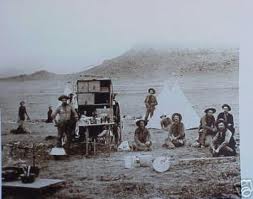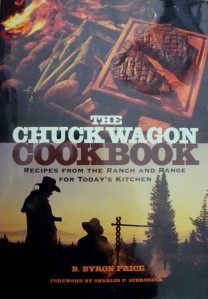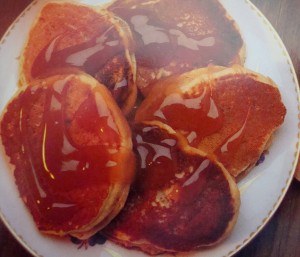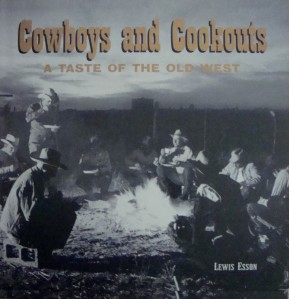CLICK ABOVE TO PLAY MUSIC
Music – “Chuck-Wagon Jamboree (Ep. 3, 1948) – The Cowboy’s Lament” from Radio & Recording Rarities, Vol. 37 by Ken Curtis and The Novelty Aces. Released: 2011
Life in the Old West conjures up a picture of the romance of cowboys rustlin’ cattle and life on the trail. Gittin’ them dogies herded up after a long day in the saddle, the cowboys meandered back to the chuck wagon, lured by the smells of “Lumpy Dick” and “Sucamagrowl” cooking in the Dutch oven. Ah, those were the good ol’ days. At least, John Wayne made it look like they were the good ol’ days.

A Chuckwagon (Photo Credit: http://www.lonehand.com)
The “Chuckwagon” was the staple of the cowboy’s existence and the cook pretty much called the shots. Many of the cooks had colourful names: “Rickety Bob”, “Sourdough Jack”, “Bellyache Charley Colic” are just a few mentioned in B. Byron Price’s book, “The Chuckwagon Cookbook”, published in 2004 (revised edition). The cooks, according to Price, “…presided over their chuck wagons as czarlike autocrats”.
In addition to their cooking talents, many cooks frequently wore the hats of barber, banker, dentist and doctor, often carrying a supply of purgatives, liniments, castor oil and such, on their chuck wagons. Pulling teeth and setting bones was one of those “other duties as assigned” parts of the job.
Cattle Drive (Photo Credit: http://www.en.wikipedia.org)
Almost as colourful as the nicknames of the cooks were the names of the food they rustled up. After a long day in the saddle, the cowboy might return to camp yearnin’ for a dish of “Spotted Pup”, a dessert made of boiled rice and raisins, although apparently some recipes also included milk, eggs and a dash of cinnamon. A cook, sometimes referred to as a “dough belly”, might concoct a kind of pudding with suet, dried fruit, water and flour, made into a dough and wrapped in a sac, which was then steamed over water in a large kettle. The dish, known as “Son-of-a-b—h in a sack” was a favourite, as was “Sucamagrowl”, a pudding consisting of water, vinegar, flour, sugar, cinnamon and sourdough.
When was the last time you had “Splatter Dabs” and “Belly Wash” for breakfast? Just fancy names for pancakes and weak coffee.
We take Jell-O for granted and it is ubiquitous everywhere, but when gelatin first came on the scene, intrigued by it’s unique quivering qualities, cowboys christened it “Shiverin’ Liz” or “Tremblin’ Jelly”. Ever eaten a “pooch”? Well, don’t call the humane society just yet, as “pooch” is just cold biscuits combined with canned tomatoes. Canned goods, although available, were still uncommon in the 1880’s, especially in the west and tinned tomatoes were especially a favorite. Don’t know who Charlie Taylor is? Well, “Charlie Taylor” is the name for a butter substitute consisting of sorghum and bacon grease, used to oil up the griddle to make “Splatter Dabs“. My guess is that a dough belly named Charlie Taylor came up with the novel idea.Coffee was the mainstay of cowboy grub and if coffee beans were as scarce as hen’s teeth, the enterprising dough belly might substitute dried maize, chicory, wheat, or sweet potato parings, according to Price in “The Chuckwagon Cookbook”. And you thought Starbucks was on the cutting edge of coffee libations!
In “Cowboys and Cookouts – A Taste of the Old West” by Lewis Esson, there is a recipe for “Texas Caviar”, which sounds luxurious, however, it was a mixture of cooked black-eyed peas, tomatoes, vinegar, olive oil, Tabasco sauce and chopped scallions. And, next time you’re cooking up a hunk of meat or a big bird, you can rustle up some nice “Trail Drive Gravy” with lard or meat drippings and a can of evaporated milk!
Next time you go camping, take your “wreck pans” and cook up a mess o’ “Fruity Fritters” or “Tit-Tat-Toe Cake” . How ’bout a snack of “Houn’ Ears & Whirlups” or “Hunkydummy”? (all recipes from “The Old West Baking Book”, by Lon Walters).
But remember the “Traditional Cowboy Proverb” – “Always take a good look at what you’re about to eat. It’s not so important to know what it is, but it’s critical to know what it was”. Sage advice from “Cowboys and Cookouts – A Taste of the Old West”. Now, go rustle up some grub.







You must be logged in to post a comment.